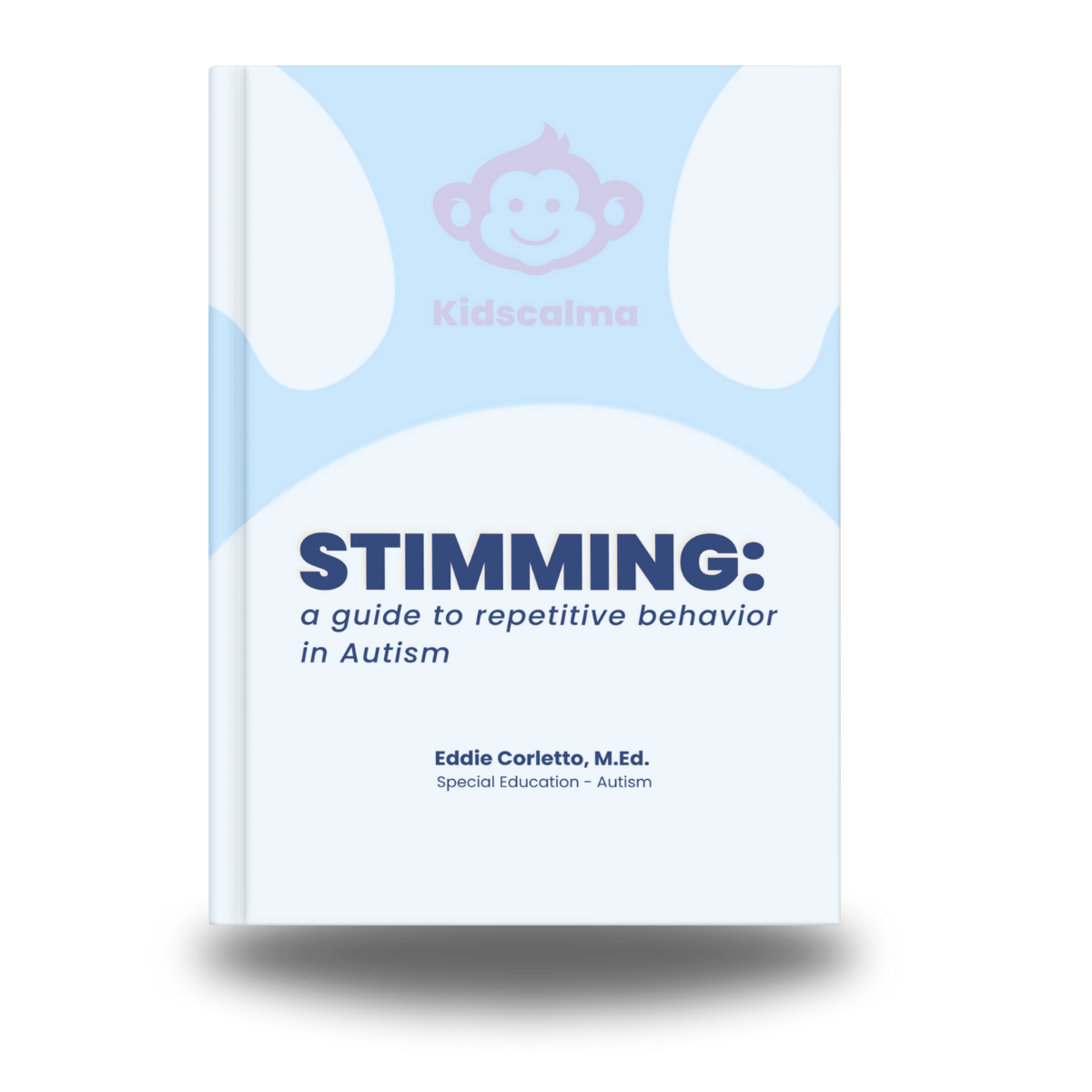Stimming: a Guide to Repetitive Behavior in Autism

Introduction
Hey there! Have you ever noticed your child flapping their hands or rocking back and forth and wondered why? That’s stimming, a natural behavior often seen in children with autism spectrum disorder. It helps them handle sensory overload and regulate emotions. Let’s dive into what stimming is, why it happens, and how we can best support our kids.
Key takeaways
- Diverse behaviors: Stimming includes actions like hand flapping, rocking, and repeating words or sounds.
- Coping mechanism: These behaviors help manage sensory input and emotions.
- Social perception: Society’s view of stimming greatly affects autistic individuals. Promoting understanding and acceptance is crucial.
Exploring stimming behaviors
Stimming encompasses a range of repetitive movements or sounds, often referred to as repetitive behavior. Common examples include nail-biting, hair twirling, hand-flapping, and rocking. Each person has personal stimming behaviors based on their sensory needs. Some might pace, walk on tiptoes, or even pull their hair out. Others might repeat certain words or phrases, known as echolalia. These behaviors reflect the broad spectrum of Autism. Each finds their ways to self-regulate and cope with their environment.
Stimming is a form of self-stimulating behavior. which are natural actions that help with self-regulation. Examples include drumming fingers, full-body movements, and obsessive behaviors. Understanding and managing these behaviors is crucial, especially when they interfere with learning, result in social exclusion, or cause harm.

Sensory input and stimming
Stimming often results from sensory overload or under-stimulation. Imagine trying to watch TV with the volume too high or too low – stimming helps find that perfect balance. Using sensory objects like soft fabrics can help manage these inputs without resorting to more disruptive behaviors. Grasping the sensory basis of self-stimulatory behavior enables us to shape environments that bolster rather than obstruct their sensory regulation needs.
Autistic individuals often live in a world where everyday sounds, lights, and textures can become overwhelming. When sensory inputs are too intense, self-stimulatory behavior provides a way to manage these sensations. For instance, using sensory objects like soft fabrics or stress balls can provide the necessary input without resorting to more disruptive behaviors. Understanding the sensory basis of self-stimulatory behavior allows us to create environments that support rather than hinder their sensory regulation.
Emotional self-regulation
Stimming isn’t just about sensory input. It’s also a way to handle emotions. Repetitive behaviors like rocking or hand-flapping can calm anxiety and stress. These actions are like an internal hug, especially when talking about feelings is tough. Engaging in these repetitive movements can provide comfort and help regulate emotions. For instance, hand flapping, rocking back and forth can serve as a self-regulatory mechanism, allowing autistic people to communicate their intense emotions and thoughts.
Stimming helps an autistic child manage emotions by providing a way to express and control their feelings. Research indicates that stimming behaviors, also called self-stimulatory behaviors, function as vital coping mechanisms, helping in controlling overpowering emotions.
However, prolonged or excessively frequent, stimming in many autistic people can sometimes exacerbate distress and negatively impact emotional regulation. Teaching self-regulation techniques such as deep breathing, progressive muscle relaxation, and mindfulness can empower autistic individuals to manage their stimming behaviors more effectively. These strategies can provide alternative ways to cope with emotions without entirely suppressing the natural stimming behaviors.
Decoding stimming
Understanding why stimming occurs helps in supporting individuals with autism spectrum disorder. Stimming can arise from sensory processing challenges, physical discomfort, or emotional needs. For example, rocking might soothe pain, while hand flapping can show excitement or anxiety. These behaviors can also serve as a means of self-soothing, helping to manage emotions and reduce stress.
Communication difficulties are another significant factor behind stimming. For many autistic individuals, expressing frustration or other intense emotions verbally can be challenging. Stimming provides an alternative outlet for these emotions, offering a non-verbal way to communicate their inner experiences.
Stimming behaviors often arise from the need to regulate emotional and sensory experiences. For many, it serves to cope with sensory processing challenges, providing a predictable and controllable response to overwhelming stimuli.
In addition to sensory processing, stimming can also be a reaction to physical discomfort or a way to deal with various mental health issues. For example, an autistic person might engage in repetitive behaviors like:
Rocking to alleviate pain or discomfort
Hand flapping to express excitement or anxiety
Spinning in circles to self-regulate
Tapping or flicking objects to provide sensory input
Excessive self-rubbing
Repeating words or phrases
These behaviors can also serve as a means of self-soothing, helping to manage emotions and reduce stress. Understanding the reasons behind stimming is fundamental for supporting individuals with autism spectrum disorder.

When stimming becomes problematic
Stimming can be harmful or disruptive. Imagine a child banging their head or scratching excessively – it can cause injury. Head banging, for instance, is a specific example of stimming behavior that can lead to physical harm and highlights the need to manage sensory and emotional environments to reduce the need for stimming.
In social settings, stimming might draw unwanted attention, leading to isolation and stress. Knowing when and why stimming happens helps in finding the right support. It can also be disruptive in social settings, such as classrooms or workplaces. When stimming behaviors are loud or visually distracting, they can interrupt activities and draw unwanted attention. This disruptiveness can lead to social stigmatization, isolation, further exacerbating the individual’s stress, and increasing the frequency of stimming behaviors.
Moreover, stimming becomes problematic when it persists for hours, becomes a frequent daily occurrence, or is constant in nature. The context, including the specific environment or situation, significantly influences how stimming is perceived – disruptive or dangerous. Understanding these nuances is essential in providing appropriate support and interventions.
Managing stimming
Managing stimming requires a balanced approach that respects the individual’s need for self-regulation while addressing any disruptive or harmful behaviors. Occupational therapists can play a pivotal role in this process, offering interventions that help individuals handle sensory challenges and manage their stimming behaviors. Despite prevalent suggestions to stop stimming, acknowledging its advantages is vital. A significant percentage of autistic adults report that stimming helps them reduce anxiety and calm down. Therefore, strategies should focus on understanding and managing stimming behaviors rather than suppressing them.
Redirecting stimming
Redirecting a child’s stimming, to more socially acceptable behaviors can be a game-changer. Creating sensory-friendly environments, using stress balls or fidget toys, and engaging in calming techniques can help meet sensory needs without being disruptive. One effective strategy is to redirect stimming behaviors to more socially acceptable alternatives, which can also help to hide stimming behavior. Here are some examples:
Creating sensory-friendly environments and defined spaces can help individuals engage comfortably in stimming while meeting social norms.
Using stress balls or fidget toys can fulfill sensory needs without being disruptive.
Engaging in deep breathing exercises or other calming techniques can provide sensory input in a more socially acceptable replacement behavior
By providing these alternatives, individuals can still engage in stimming behaviors while respecting social expectations. Replacement activities that are engaging and social can also serve as alternatives to stimming. These activities not only meet sensory needs but also enhance relationship skills, allowing for more comfortable interactions in social situations. By providing these alternatives, we help autistic individuals navigate social environments more effectively without suppressing their need for self-regulation.
Incorporating self-regulation tools
Fidget toys like spinners, stress balls, and tangle toys can help manage stimming behaviors. These tools provide controlled ways to cope with sensory input and can be integrated into daily routines. The inclusion of self-regulation tools like fidget toys can be greatly advantageous in controlling stimming behaviors. Some examples of fidget toys include:
Fidget spinners
Stress balls
Tangle toys
Fidget cubes
These tools help limit repetitive motion to the hands, providing a controlled way to cope with sensory input. They can be particularly helpful in environments where more conspicuous stimming behaviors might be disruptive. For some individuals, using fidget toys can also relieve physical discomfort, offering a practical means of self-regulation. By integrating these tools into daily routines, we can support autistic individuals in managing their stimming behaviors more effectively.
Social perceptions
Social perceptions significantly influence how stimming is viewed and managed. Misconceptions often lead to stigma and negative responses. Promoting acceptance through positive media portrayals and educational training is essential. Social perceptions of stimming play a significant role in how these behaviors are viewed and managed. Unfortunately, cultural beliefs and misconceptions often lead to stigma and negative societal responses. This stigma can be exacerbated by factors such as the level of understanding and visibility of autistic traits, as well as personal differences and whether an autism diagnosis has been disclosed.
If stimming behaviors are considered socially unacceptable, they can result in social stigmatization and isolation for autistic individuals. This isolation can increase stress and exacerbate stimming behaviors. To neutralize this stigma, nurturing acceptance and understanding through interventions such as
“autism-friendly” environments, positive media portrayals, positive reinforcement, and educational training is of utmost importance.
Autism research insights
Current research continues to document the prevalence of stimming behaviors and the importance of interaction with the autistic community. Accepting stimming as a component of the autistic experience, instead of trying to suppress it, supports the viewpoints of autistic individuals.

Summary
In summary, stimming is a multifaceted behavior that serves essential functions for individuals with Autism. Stimming behavior regulates sensory input, manages emotions, and provides non-verbal individuals with a way to communicate. Stimming is a vital part of the autistic experience.
Understanding the reasons behind stimming and recognizing when it becomes problematic allows for more effective support and interventions.
Embracing strategies that respect the benefits of stimming while providing alternatives for socially acceptable behaviors can help autistic individuals navigate their environments more comfortably. By fostering acceptance and understanding, we can create a more inclusive society that supports the unique needs of autistic individuals.
Frequently Asked Questions
What is stimming in autism spectrum disorder?
Stimming, short for ‘self-stimulation,’ involves repetitive movements or sounds that help autistic individuals manage sensory input and emotions. It is a self-regulating behavior that can vary widely among individuals.
When does stimming become problematic?
Stimming becomes problematic when it is disruptive in social settings, persistent to the point of causing self-harm, distress, or self-injurious. It’s important to seek support if you or someone you know is experiencing these challenges.
How can stimming be managed effectively?
You can effectively manage stimming through occupational therapy, redirecting to socially acceptable behaviors, using self-regulation tools, and creating sensory-friendly environments. This approach can help individuals with stimming behaviors thrive in daily life.
How can society better understand and accept stimming behaviors?
Society can better understand and accept self-stimulatory behaviors by promoting positive media representation, offering educational training, and creating ‘autism friendly’ environments that support autistic individuals. This can help in creating a more inclusive and supportive community for individuals who stim.
Author Bio

Hey there! I’m Eddie Corletto, the passionate mind behind kidscalma.com. A proud father of an autistic teenager. A special education teacher with over ten years of experience in the classroom. I hold a master’s degree specializing in Autism and Sensory Processing Disorders. I am deeply committed to supporting autistic children and their families. Kidscalma is my platform to share both my professional and personal experiences. I specialize in creating helpful resources for parents and educators supporting children on the Autism spectrum, Sensory Processing Disorder, and other learning disabilities. When I’m not in my classroom or writing, you might catch me hiking with my family or cycling around the scenic roads of California’s Central Coast. I believe our children can achieve amazing things every day. Connect with me on Facebook or subscribe to my blog for more insights and resources!

STIMMING: A GUIDE TO REPETITIVE BEHAVIOR IN AUTISM
Eddie Corletto, M.Ed. Special Education
Published July 04, 2024
Like and Follow us on Facebook Page and visit may our Amazon Store
Other blogs
Sensory Overload in Autism and SPD: A Parent’s Guide
Sensory Overload Sensory overload is a term that resonates deeply with parents of exceptional children. It describes a state where the brain...
Why Autism Head Banging Happens and how to Help?
Navigating the challenges of self-injurious behaviors (SIBs), including head banging behavior, can be emotionally challenging for families of...
Why are Sensory Swings Essential for Kids With Autism?
A therapy swing, also known as a sensory swing, like the one shown by Kidscalma, is a tool that helps manage Sensory Processing Disorders. It does...
How Weighted Lap Pads Calm Sensory Overload?
It can be hard to deal with sensory problems in autistic children. But with tools like the weighted lap pad from Kidscalma, we can make them feel...
Toilet Training Autistic Children
Toilet training autistic children can be an overwhelming process, and it often brings an additional layer of challenges. If you’re feeling uncertain...
